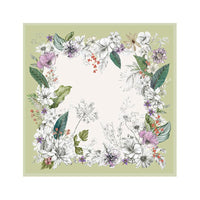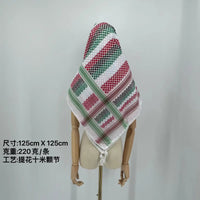Have you ever noticed those intricate, teardrop-shaped swirls—like commas or ornate droplets—on your grandfather’s vintage tie, your mother’s silk scarf, or the dazzling jacket of a hip-hop artist? That’s "paisley". But its true story runs far deeper than its name suggests.
The Eastern Code of the Tree of Life
Paisley’s roots stretch back to Persia (modern-day Iran). Its original name comes from the Persian “boteh jegheh”—an abstract motif combining the cypress tree (a symbol of life and immortality in Persian culture) and floral forms. It was revered as the embodiment of the "Tree of Life," carrying blessings of prosperity and eternity.

Eastern Treasure, Western Obsession
When exquisitely crafted Kashmiri shawls traveled the Silk Road to the West, their exotic patterns captivated European nobility. Particularly in the early 19th century, after Napoleon gifted Josephine a Kashmiri shawl brought back from his Egyptian campaign, the aristocracy became utterly obsessed with these Eastern treasures.
Genuine Kashmiri shawls, however, cost as much as gold. Soaring demand spurred imitation. "The Scottish town of Paisley", with its advanced textile industry, succeeded in mass-producing affordable shawls featuring the pattern. From then on, "Paisley" became the Western name for this iconic design.

From Aristocratic Luxury to Street Culture
The 20th century saw paisley undergo a dramatic identity shift
Democratization & Rebellious Undertones (Early-Mid 20th Century):
Advances in printing brought paisley to ties, scarves, and home goods. Yet, in the relatively conservative 50s, its bold complexity sometimes earned it a "garish" label.
Hippie Spirit Symbol (1960s-70s):
The true turning point came in the 60s! The hippie movement embraced Eastern philosophy and non-Western cultures. Paisley’s psychedelic, flowing lines perfectly embodied the "peace and love" ethos and the visual experience of altered states. John Lennon’s Rolls-Royce and Jimi Hendrix’s shirts became moving billboards for paisley, transforming it from "fusty" to a cool icon of rebellion and spiritual exploration.

The Dazzling Hip-Hop Revival
As hip-hop culture exploded on the streets of New York in the 1980s, a desire for "Gaudy Opulence" emerged. Early hip-hop icons sought to defy their roots, using flamboyant fashion to declare their success and presence.
Enter legendary designer Dapper Dan. His Harlem boutique boldly reimagined luxury – taking Louis Vuitton, Gucci, and other iconic monograms and splashing them, enlarged and densely packed (often with a slightly "knock-off" feel), across entire leather garments (baseball jackets, coats). Crucially, he fused them with vibrant, oversized paisley patterns as backgrounds or focal points.
This was street-smart and provocative: It appropriated symbols of European wealth and privilege, merging them with paisley – a pattern rich in history yet marginalized by mainstream fashion – to create a uniquely street-born, in-your-face aesthetic shouting "I'm here, I've made it."This became the ultimate evolution of Logomania.

From Courtroom to Catwalk
Ironically, Dapper Dan's bold "reinterpretations" led to lawsuits from luxury houses (like Gucci), forcing his shop to close. History, however, proved him visionary. Decades later, when streetwear fully upended high fashion's rules, Gucci and others actively embraced the very street energy they once fought.
In 2017, then-Gucci creative director Alessandro Michele released a collection featuring a direct replica of the infamous monogram-and-paisley jacket Dapper Dan made for Olympian Diane Dixon – the very piece that sparked the lawsuit. This wasn't just homage; it was official recognition and absorption of street culture's power. Paisley, central to Dapper Dan's aesthetic, was fully legitimized, taking center stage in luxury fashion.

Conclusion:The Eternal, Fluid Motif
From a sacred Tree of Life on the Persian plateau to luxurious adornment on European nobility; from a working-class alternative woven on Scottish looms to the uniform of rebellious hippies; finally, through hip-hop's ingenuity and luxury's reinvention, becoming a global icon – paisley’s every transformation reflects the spirit of its time.
It flows like a cultural river, traversing geography, class, and centuries. Next time you see those ornate paisley curls, remember: within that small pattern lies a millennium-spanning dialogue of civilizations and a fashion saga of imitation, disruption, appropriation, and rebirth.
Tip:When thrifting, paisley on silk or cashmere often carries a classic vibe, while modern cotton or polyester prints lean street. Pattern size and color saturation are key clues to era and style.
[Paisley’s journey is far from over. It’s no mere decoration, but an active, replicating strand in our cultural DNA. What new story will it tell in the next wave of history?]





